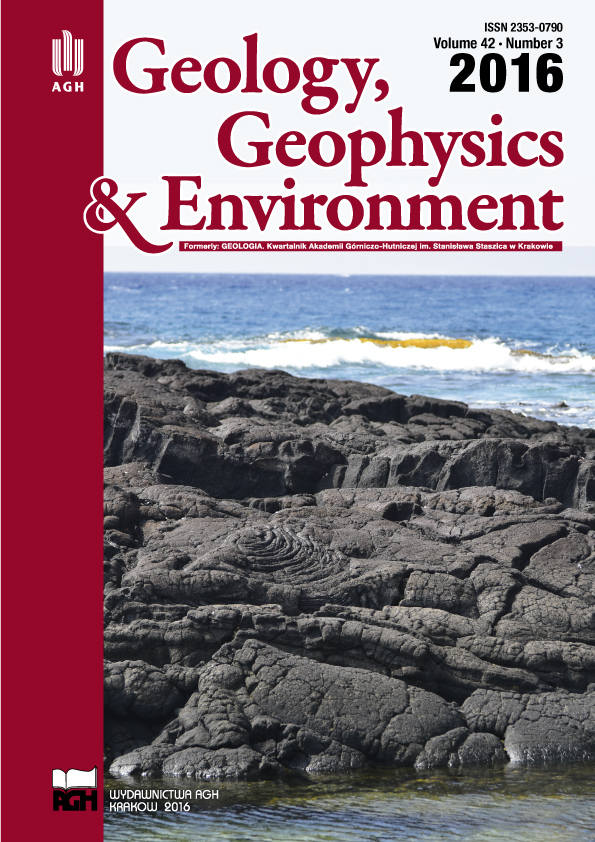A Big Data processing strategy for hybrid interpretation of flood embankment multisensor data
DOI:
https://doi.org/10.7494/geol.2016.42.3.269Keywords:
Flood embankment, anomaly detection, numerical modelling, Big Data, flood embankment stability assessmentAbstract
The assessment of flood embankments is a key component of a country’s comprehensive flood protection. Proper and early information on the possible instability of a flood embankment can make it possible to take preventative action. The assessment method proposed by the ISMOP project is based on a strategy of processing huge data sets (Big Data). The detection of flood embankment anomalies can take two analysis paths. The first involves the computation of numerical models and comparing them with real data measured on a flood embankment. This is the path of model-driven analysis. The second solution is data-driven, meaning time series are analysed in order to detect deviations from average values.
Flood embankments are assessed based on the results of model-driven and data-driven analyses and information from preprocessing. An alarm is triggered if a critical value is exceeded in one or both paths of analysis. Tests on synthetic data demonstrate the high efficiency of the chosen methods for assessing the state of flood embankments.
Downloads
References
Balis B., Kasztelnik M., Bubak M., Bartynski T., Gubała T., Nowakowski P. & Broekhuijsen J., 2011. The urbanflood common information space for early warning systems. Procedia Computer Science, 4, 96–105.
Biot M.A., 1955. Theory of elasticity and consolidation for a porous anisotropic solid. Journal of Applied Physics, 26, 2, 182–185.
Borys M., 2007. Przepisy i wymogi oraz aktualny stan obwałowań przeciwpowodziowych w Polsce. Woda-Środowisko-Obszary Wiejskie, 20, 7, 25–44.
Chuchro M., Lupa M. & Pięta A., 2015. A concept of time windows length selection in stream databases in the context of sensor networks monitoring. [in:] Bassiliades N. et al. (eds.), New Trends in Database and Information Systems II, Advances in Intelligent Systems and Computing, 312, Springer International Publishing, 173–183.
Itasca Consulting Group, I. 2011. FLAC Fast Lagrangian Analysis of Continua and FLAC/Slope – User’s Manual.
Krzhizhanovskaya V.V., Shirshov G.S., Melnikova N.B., Belleman R.G., Rusadi F.I., Broekhuijsen B.J., Gouldby B.P., Lhomme J., Balis B., Bubak M., Pyayt A.L., Mokhov I.I., Ozhigin A.V., Lang B. & Meijer R.J., 2011. Flood early warning system: design, implementation and computational modules. Procedia Computer Science, 4, 106–115.
Kotu V. & Deshpande B., 2015. Predictive Analytics and Data Mining: Concepts and Practice with RapidMiner. Morgan Kaufmann.
Maslova I., Ticlavilca A. M. & McKee M., 2016. Adjusting wavelet-based multiresolution analysis boundary conditions for long-term streamf low forecasting. Hydrological Processes, 30, 1, 57–74.
Melnikova N.B., Shirshov G.S. & Krzhizhanovskaya V.V., 2011. Virtual Dike: multiscale simulation of dike stability. Procedia Computer Science, 4, 791–800.
Pengel B.E., Krzhizhanovskaya V.V., Melnikova N.B., Shirshov G.S., Koelewijn A.R., Pyayt A.L. & Mokhov I.I., 2013. Flood early warning system: sensors and internet. [in:] Floods: From Risk to Opportunity, IAHS Publication, 357, International Association of Hydrological Science, 445–453.
Pięta A. & Krawiec K., 2015. Random set method application to flood embankment stability modelling. Procedia Computer Science, 51, 2668–2677.
Piórkowski A. & Leśniak A., 2014. Using data stream management systems in the design of monitoring system for flood embankments. Studia Informatica, 35, 2, 297–310.
Pyayt A.L., Shevchenko D.V., Kozionov A.P., Mokhov I.I., Lang B., Krzhizhanovskaya V.V. & Sloot P.M.A., 2015. Combining Data-Driven Methods with Finite Element Analysis for Flood Early Warning Systems. Procedia Computer Science, 51, 2347–2356.
Pyayt A.L., Mokhov I.I, Kozionov A.P., Kusherbaeva V.T., Lang B., Krzhizhanovskaya V.V & Meijer R.J., 2012. Data-driven modelling for flood defence structure analysis. [in:] Klijn F. & Schweckendiek T. (eds.), Comprehensive Flood Risk Management: Research for Policy and Practice, CRC Press, Boca Raton, 77.
Welch P.D., 1967. The use of Fast Fourier Transform for the Estimation of Power Spectra: A method based on time averaging over short, modified periodograms. IEEE Transactions on Audio and Electroacoustics, 15, 2, 70–73.
Zieliński M. & Chrost A., 2015. ASP Czernichów. Eksperymentalny wał przeciwpowodziowy – projekt, wykonanie w części dotyczącej poboru, transmisji i wizualizacji danych. Internal documents of ISMOP project.
Downloads
Published
Issue
Section
License
Authors have full copyright and property rights to their work. Their copyrights to store the work, duplicate it in printing (as well as in the form of a digital CD recording), to make it available in the digital form, on the Internet and putting into circulation multiplied copies of the work worldwide are unlimited.
The content of the journal is freely available according to the Creative Commons License Attribution 4.0 International (CC BY 4.0)










